现代SUV总布置设计
现代SUV轿车车身总布置设计毕业设计

要 摘
�文论�计设业毕生科本
II
espilleye � tuoyal ydoB otuA �scimonogrE�sdrow yeK .seirossecca suoirav eht
yfitne di dna ngised ,yllaniF.evruc epolevne eht dna ecafrus epolevne daeh eht,ngised tsom dna sledom eht enimreted ot scimonogre ylppa osla,setanidrooc elcihev eht fo dna ngised evitomotua fo tnempoleved eht no desab si ngised evitomotua ehT espilleye eht,ngised taes,tniop H eht enimreted dnA.noi tisop ydob elbatrofmoc
现代汽车驾驶室的人机工程设计
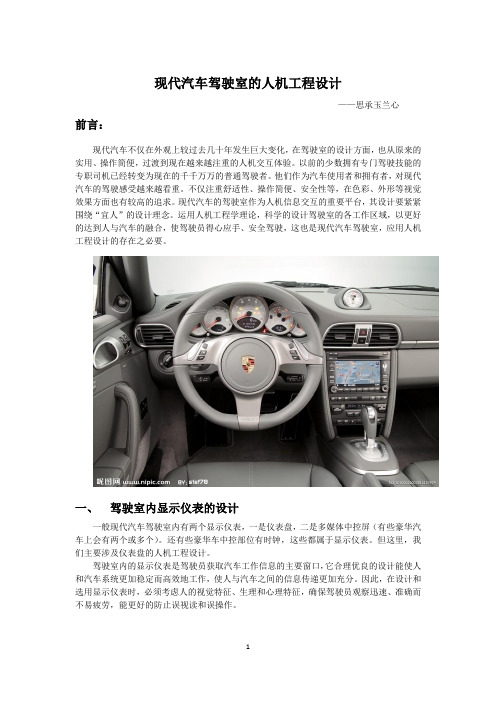
现代汽车驾驶室的人机工程设计——思承玉兰心前言:现代汽车不仅在外观上较过去几十年发生巨大变化,在驾驶室的设计方面,也从原来的实用、操作简便,过渡到现在越来越注重的人机交互体验。
以前的少数拥有专门驾驶技能的专职司机已经转变为现在的千千万万的普通驾驶者。
他们作为汽车使用者和拥有者,对现代汽车的驾驶感受越来越看重。
不仅注重舒适性、操作简便、安全性等,在色彩、外形等视觉效果方面也有较高的追求。
现代汽车的驾驶室作为人机信息交互的重要平台,其设计要紧紧围绕“宜人”的设计理念。
运用人机工程学理论,科学的设计驾驶室的各工作区域,以更好的达到人与汽车的融合,使驾驶员得心应手、安全驾驶,这也是现代汽车驾驶室,应用人机工程设计的存在之必要。
一、驾驶室内显示仪表的设计一般现代汽车驾驶室内有两个显示仪表,一是仪表盘,二是多媒体中控屏(有些豪华汽车上会有两个或多个)。
还有些豪华车中控部位有时钟,这些都属于显示仪表。
但这里,我们主要涉及仪表盘的人机工程设计。
驾驶室内的显示仪表是驾驶员获取汽车工作信息的主要窗口,它合理优良的设计能使人和汽车系统更加稳定而高效地工作,使人与汽车之间的信息传递更加充分。
因此,在设计和选用显示仪表时,必须考虑人的视觉特征、生理和心理特征,确保驾驶员观察迅速、准确而不易疲劳,能更好的防止误视读和误操作。
1. 仪表盘位置1) 视角:一般人的最佳眼睛转动区为左15°右15°、上25°下25°,即驾驶员的视野在这个范围内观察重要行车仪表数据时,看到的影像最清楚。
因此,在设计时应把仪表盘大致布置在此范围内。
人的水平视野和垂直视野2) 视距:一般人的操作视距范围在38~76cm 之间。
即驾驶员在操作系统中正常的观察距离在此范围内,所以,在设计时应把仪表盘大致布置在此范围内。
2. 仪表形式仪表的形式因其用途不同而异。
仪表盘作为重要信息的显示系统,它不仅显示重要的行车参数如车速、转速、行驶里程、油量,还有车辆安全数据信息如机油压力、冷却水温度、和胎压监测以及一些警示提醒。
现代汽车的设计方法

现代汽车的设计方法现代汽车的设计方法是一个复杂而综合性的过程,它涉及到多个方面,包括外观设计、车身结构设计、动力系统设计、内饰设计、人机工程学设计等等。
现代汽车的设计方法主要可分为以下几个步骤:1. 市场调研:在设计一款新车型之前,汽车设计师需要进行市场调研,了解消费者的需求和喜好。
这样可以使设计师更好地把握市场需求和潮流趋势,确保设计的产品能够满足消费者的需求。
2. 概念设计:在进行市场调研后,设计师会进行概念设计,包括外观造型、车身结构、车辆比例等。
概念设计是一个创意过程,设计师需要将市场需求和自己的创意相结合,形成独特而富有吸引力的设计方案。
3. 造型设计:在概念设计确定后,设计师会进行具体的造型设计。
这一过程涉及到外观线条的塑造、曲线的修饰、细节的雕琢等。
设计师需要运用各种设计软件和工具,如CAD、CAM等,来实现设计图纸的绘制和模型的制作。
4. 工程设计:在完成造型设计后,设计师需要进行工程设计,包括车身结构设计、动力系统设计、底盘设计等。
这一步骤需要考虑到安全性、可靠性、乘坐舒适性等方面的要求。
设计师需要与工程师紧密合作,确保设计方案的可行性。
5. 内饰设计:在设计过程中,内饰设计也是非常重要的一环。
内饰设计需要考虑到人机工程学、乘坐舒适性、功能性等方面的要求。
设计师需要和工程师、人机工程学专家等密切合作,确保内饰设计与整车设计相协调。
6. 原型制作:在设计方案确定后,设计师会制作原型车或3D打印模型。
通过原型的制作,设计师可以更好地了解设计方案的实际效果,并进行调整和改进。
原型制作是设计过程中的一个关键环节。
7. 试制和测试:在原型制作完成后,设计师会进行试制和测试。
这一步骤涉及到车辆性能测试、安全性测试等,以确保设计方案的可靠性和安全性。
8. 生产准备:在设计方案得到验证和完善后,设计师需要进行生产准备。
这一步骤涉及到工艺设计、生产工艺准备、供应链管理等。
设计师需要和工程师、生产经理等密切合作,确保设计方案能够顺利投入生产。
汽车总布置设计(37页)PPT课件
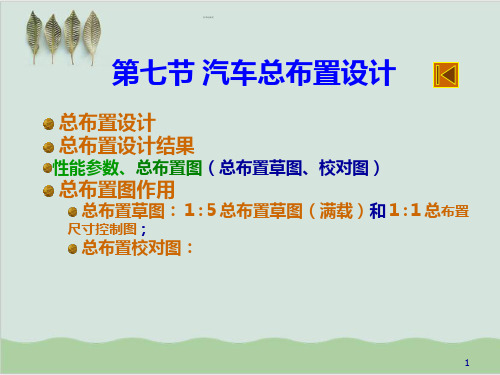
3、转向装置布置
转向盘的位置-保证驾驶员能舒适 地进行转向操作
转向器的位置-转向器布置在前钢 板弹簧跳动中心附近
转向器用万向节和转向传动轴将它 们连接起来
转向轴在水平面内与汽车中心线之 间的夹角不得大于5°
转向摇臂与纵拉杆和转向节臂与纵 拉杆之间的夹角,在中间位置时应尽 可能布置成接近直角。
11
Z αF
前轮中心线 前轮垂直线
O
O1
r0 rr
a
车架上平面线
后轮中心线
αF(0.5°~1.5°)
r0
Байду номын сангаас
后轮垂直线
X
O2
rr
b
A
L
B
6
总布置基准线-坐标系
Z
前轮 中心线
αF
前轮垂直线
后轮中心线 后轮垂直线
O
车架上平面线
XY
Y 前轴中心线
αF
地面线
后轴中心线
汽车中心线
Z
汽车中心线
7
二、各部件的布置
1、动力总成(发动机-离合器-变速器)布置
初期)、1:2和1:1。
21
(2)人体样板(续) 布置人体样板时,首先要确定其踵点与胯点的位置;
人体样板上的胯点要与初选的座椅上的“胯”点重合; 人体样板的踵点应安放在油门踏板处的地板上的踵点。
然后根据选定的坐姿角α、β、γ及δ在图样上进行布置, 检查初选的b值等是否合适。
驾驶时,人体各部分的夹角应符合人体工程学的要求。
αE
γ1
αr
γ2
车架上平面线
主减速器主动轴线位置-与车架上平面有一个夹角αr(4°~7°),即向上 翘起,以减小传动轴夹角,并使万向节传动轴两端夹角相等。轿车常将传 动轴布置成U形方案(图1-19),可降低传动轴轴线的高度,有利于客厢 地板和后排中间座椅的布置(减小地板凸包);
汽车总布置设计规范

汽车总布置设计规范汽车设计规范是为了确保车辆在设计、制造和使用过程中具有一定的标准和规范。
这些规范涵盖了外观设计、结构设计、安全性能、环境表现等方面,以保证汽车在所有方面都能满足用户的需求并达到安全性能、经济性能和环保性能的要求。
首先,汽车设计规范要求外观设计符合人体工学原理,保证乘坐舒适性和操作便捷性。
车身外形应流线型,减少空气阻力和噪音。
同时,要遵循品牌识别和设计风格,确保每款车都具有独特的外观特征。
其次,汽车的结构设计需要符合一定的标准和规范,以确保车辆在运行过程中具有足够的刚度和强度。
车身结构应具有一定的安全保护能力,能够有效吸收和分散碰撞能量。
底盘设计要合理布置零部件,确保车辆在各种路况下稳定性和操控性。
安全性能是汽车设计规范中最重要的一项内容,包括主动安全和被动安全两个方面。
主动安全要求车辆具备良好的操控性和制动性能,以便驾驶员在紧急情况下能够迅速做出反应。
被动安全要求车辆在发生碰撞时能够提供有效的保护,减少乘员伤害。
这包括安全气囊、防护结构、安全带等安全装置的合理设计和配置。
另外,环保性能也是汽车设计规范中的重要内容。
随着环保意识的提高,汽车的排放要求越来越严格。
汽车设计规范要求车辆采用先进的节能技术和清洁动力,能够减少尾气排放,减小对环境的污染。
此外,轻量化设计也是一个重要的环保要求,通过采用轻量材料和结构设计的优化,降低汽车的油耗,减少能源消耗。
除了以上方面的规范,汽车设计还要考虑人机工程学、噪音振动、耐久性、可维修性、可靠性等方面的要求。
汽车设计规范的严谨和细致,不仅对于车辆制造商来说是对产品质量的保证,对于消费者来说也是对驾驶安全和舒适性的保障。
总之,汽车设计规范是汽车制造行业的重要指导标准,它涵盖了外观设计、结构设计、安全性能、环境表现等方面。
通过遵从这些规范,车辆能够满足用户需求,保障驾驶安全、舒适性和环保性能。
同时,在不断科技进步的背景下,汽车设计规范也将不断更新和完善,以适应市场的需求和环境的变化。
现代汽车工厂规划方案

现代汽车工厂规划方案一、工厂布局1.总体布局:工厂整体采用流水线生产方式,以提高生产效率。
同时,采用分区布局,将工厂分为原料仓库、生产车间、装配车间、成品仓库、办公区等功能区域。
2.原料仓库:位于工厂的一侧,在离生产车间较近的位置。
原料仓库应设置合理的货物分区,确保原料的储存和取用方便快捷。
3.生产车间:设立主要的生产线和生产设备。
根据生产需求和车辆组装流程,合理划分生产车间,确保每个生产阶段的工作顺利进行,同时尽量减少物料和人员的行走距离。
4.装配车间:设有专门的装配工位和装配线,用于完成整车组装和零部件的装配。
根据车型和生产计划,合理安排装配车间的布局,提高车辆组装的效率。
5.成品仓库:位于工厂的另一侧,在离装配车间较近的位置。
成品仓库应设立合理的存货分区,确认各个车型的存放位置,方便出货和发运。
6.办公区:设有办公室、会议室、员工餐厅等功能区域。
办公区应与生产区域分开,以减少噪音和杂乱的干扰,同时提供员工舒适的工作环境。
二、设备配置1.生产设备:根据汽车组装需求,购置适当的生产设备和装配线。
设备要具备高效、稳定和智能化的特点,以提高生产效率和质量,并满足财务目标。
2.贮存设备:为了方便原材料和成品的储存和取用,工厂应配备合适的贮存设备,如货架、叉车、堆高机等。
设备要安全可靠,提高存货的使用效率。
3.检测设备:为了确保每辆车都符合质量标准,工厂应购置适当的检测设备,如动力学检测设备、排放检测设备、质量检测设备等。
设备要精确可靠,确保产品质量。
4.辅助设备:根据生产需求,工厂还应购置适量的辅助设备,如压缩空气设备、冷却设备、污水处理设备等。
设备要符合环保要求,减少资源浪费和环境污染。
三、流程优化1.生产流程优化:通过对生产流程进行分析和改进,减少各工序之间的等待时间,提高生产效率。
同时,采用先进的物流管理系统,实现生产自动化和信息化。
2.供应链管理优化:与供应商建立良好的合作关系,优化供应链管理。
汽车总布置形式

灵活调整座椅位置
通过可调式座椅,根据不 同身材的乘员进行个性化 调整,提高乘坐舒适度。
座椅布置实例分析
轿车座椅布置
轿车采用四座、五座、七座等 不同的座椅布置形式,以满足
不同消费者的需求。
MPV座椅布置
MPV具有更大的空间,可采用多 种座椅布置形式,如2+2+2或 2+3+2等。
SUV座椅布置
SUV的座椅布置与MPV类似,但更 加注重越野性能和载物能力。
06
汽车总布置形式的优化与 改进建议
优化车身形式以改善空气动力性能
流线型车身
通过采用流线型车身设计,减少空气阻力和风噪 ,提高车辆的燃油经济性和行驶稳定性。
车身间隙优化
合理设计车身间隙,减少空气流动受阻,降低风 阻系数,提高车辆的空气动力性能。
车身高度调整
针对不同行驶需求,适当调整车身高度,以优化 空气动力性能,提高车辆行驶稳定性。
优化座椅布置以提高乘坐舒适性
座椅形状与材质
选用符合人体工程学的座椅形状和材质,提供更好的支撑和舒适 度,降低驾驶疲劳。
座椅调节功能
引入座椅调节功能,根据驾驶者身高、体型等因素个性化调节, 提高乘坐舒适性和驾驶安全性。
座椅间距优化
合理设计座椅间距,确保乘坐空间充足,提高乘坐舒适性和乘客 安全性。
THANKS
特点
不同的总布置形式具有不同的空间利用率、性能表现和舒适 性等特征。例如,发动机前置前驱车型具有较好的前部视野 和空间利用率,而后置后驱车型则具有更好的动力性和操控 性。
汽车总布置形式的重要性
直接影响到车辆的性能表现和舒适性
01
不同的总布置形式会对车辆的动力性、操控性、燃油经济性、
suv汽车发动机舱布置设计学士学位论文

各专业完整优秀毕业论文设计图纸摘要目前国内SUV汽车产品市场主要品牌都被国外的汽车大公司垄断,为了提高我国汽车工业的自主开发能力,开发SUV汽车具有重要的战略意义。
SUV的发动机舱的布置就是SUV开发的重要环节,发动机布置设计参数包括离地间隙、接近角、离去角、发动机布置形式和变速箱型号,布置动力总成时考虑发动机的振动包络,预留足够间隙。
在布置冷却液罐、蓄电池等经常需要维护的部分时安装维修的便捷显的更为重要。
遵循先布置大总成后布置小零件的原则,合理安排空间,最后完成发动机舱的布置,这就是传统发动机舱布置设计。
但是考虑到近年来汽车安全的主流欧洲行人的保护,传统的布置就难以满足需要了。
虽然现在国内没有相关行人保护的条文,但是国产汽车终将与国际接轨,所以行人保护将是近期发动机舱布置设计的新重点。
本文在以往的发动机布置设计基础上增加行人保护的相关设计。
关键词:发动机舱,行人保护,碰撞,空间SUV automobile engine compartment arrangement designABSTRACTAt present the domestic SUV automobile produce market main brand all is monopolized by the overseas automobile big company, in order to enhance our country automobile industry the independent development ability develops the SUV automobile to have the important strategic sense.Considered the engine the vibration envelope, reserves the enough gap. In the arrangement refrigerant pot, the accumulator cell and so on frequently need to maintain when part installs the service conveniently to reveal is more important. After follows first arranges greatly always becomes arranges the small components the principle, reasonably arranges the space, finally completes the engine compartment the arrangement, this is the tradition engine compartment arrangement design, but considered recent years auto safety the mainstream Europe pedestrian's protection, the traditional arrangement on met the needs with difficulty. Although the present domestic has not been connected the article which the pedestrian protects, but the domestically produced automobile end with international will connect rails, therefore the pedestrian will protect will be the near future engine compartment arrangement design new key point. This article increases the correlationdesign in the former engine arrangement design foundation, which the pedestrian protects.Key word: The engine compartment, the pedestrian protects, collision, spaceSUV汽车发动机舱布置设计董禾卿02610630引言SUV起源于美国,也是近年在美国市场最畅销的车种。
车身总布置设计内容

(a)单根万向传动轴 (b)装有中间支承的双根万向传动轴 第4章 基于人机工程学的车身布置设计
在总布置草图上,动力总成的位置由曲轴中心线与发动机气缸体前端的交点K和曲轴中心 线的倾角(轿车一般为3°~4°)来确定,其中b代表 K点到地面的高度尺寸,标明发动机 高度位置,c代表K点到前轮中心线之间的距离,标明发动机的前后位置。
第4章 基于人机工程学的车身布置设计
4.2 车身总布置设计内容
(2)传动系的布置(对于FR布置形式)
第4章 基于人机工程学的车身布置设计
4.2 车身总布置设计内容
发动机前置前轮驱动轿车的燃油箱和备胎的几种布置方案
(a)燃油箱和备胎位 (b)燃油箱在后排座后面, (c)燃油箱在后桥前方, (d)燃油箱在后桥后方,
第4章 基于人机工程学的车身布置设计
4.2 车身总布置设计内容
4. 地板布置与轮罩形状
(1)地板布置
地板布置时,地板平面位置在保证必要的离地间隙的情况下应尽可能低,以降 低汽车质心,提高汽车高速行驶的稳定性。地板的高度取决于离地间隙、车架纵 梁或底架中梁和横梁(加强地板用)的截面高度。有车架时,必须计入大梁横截 面及其上平面与车身地板之间的距离。
第4章 基于人机工程学的车身布置设计
4.2 车身总布置设计内容
车身总布置之前,首先要确定车身三维坐标系。 车身坐标系中,X指汽车的前进方向,Y为左右方向,Z为上下方向,长宽高三个方向的 零平面选取原则是: 1)宽度方向的零平面OY:通过汽车纵向对称中心线的垂直平面,右侧为正,左侧为负。 2)长度方向的零平面OX:通过汽车前轮中心线,且与OY平面和OZ平面都垂直的平面。 3)高度方向的零平面OZ:与OX平面和OY平面都垂直的平面, OZ平面上方为正,下方 为负。
简述汽车总布置设计的含义
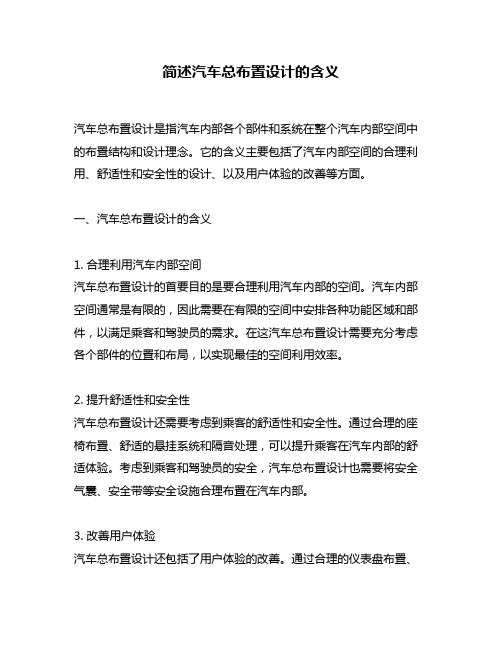
简述汽车总布置设计的含义汽车总布置设计是指汽车内部各个部件和系统在整个汽车内部空间中的布置结构和设计理念。
它的含义主要包括了汽车内部空间的合理利用、舒适性和安全性的设计、以及用户体验的改善等方面。
一、汽车总布置设计的含义1. 合理利用汽车内部空间汽车总布置设计的首要目的是要合理利用汽车内部的空间。
汽车内部空间通常是有限的,因此需要在有限的空间中安排各种功能区域和部件,以满足乘客和驾驶员的需求。
在这汽车总布置设计需要充分考虑各个部件的位置和布局,以实现最佳的空间利用效率。
2. 提升舒适性和安全性汽车总布置设计还需要考虑到乘客的舒适性和安全性。
通过合理的座椅布置、舒适的悬挂系统和隔音处理,可以提升乘客在汽车内部的舒适体验。
考虑到乘客和驾驶员的安全,汽车总布置设计也需要将安全气囊、安全带等安全设施合理布置在汽车内部。
3. 改善用户体验汽车总布置设计还包括了用户体验的改善。
通过合理的仪表盘布置、易于操作的按钮设计以及人性化的空调系统等,可以改善用户在汽车内部的体验,提升汽车的驾驶乐趣和舒适性。
二、我的个人观点和理解在我看来,汽车总布置设计的含义不仅仅是对汽车内部空间的利用,更是对汽车整体性能和用户体验的综合设计。
一个好的汽车总布置设计,应该是能够充分考虑到乘客的需求和舒适性,满足驾驶员的操作便捷性,以及保障汽车行驶过程中的安全性。
只有在这些方面都得到兼顾和满足的情况下,我们才能称之为一款优秀的汽车。
总结回顾:汽车总布置设计是汽车制造中至关重要的一个环节,它不仅仅关乎汽车内部空间的布局,更关乎汽车的舒适性、安全性和用户体验等方面。
一个成功的汽车总布置设计,应该是能够在空间利用、舒适性和安全性等方面做到完美的结合,让乘客和驾驶员都能够得到优质的体验。
汽车总布置设计是汽车内部空间的设计与布局,是汽车设计中不可或缺的重要环节。
它不仅关乎汽车的外观美观,更涉及到乘客乘坐舒适性、安全性和用户体验等方面。
在汽车总布置设计中,设计师需要充分考虑乘客和驾驶员的需求,合理利用有限的空间,提升汽车的实用性和舒适性。
SUV外形尺寸参数分析表-7座布置
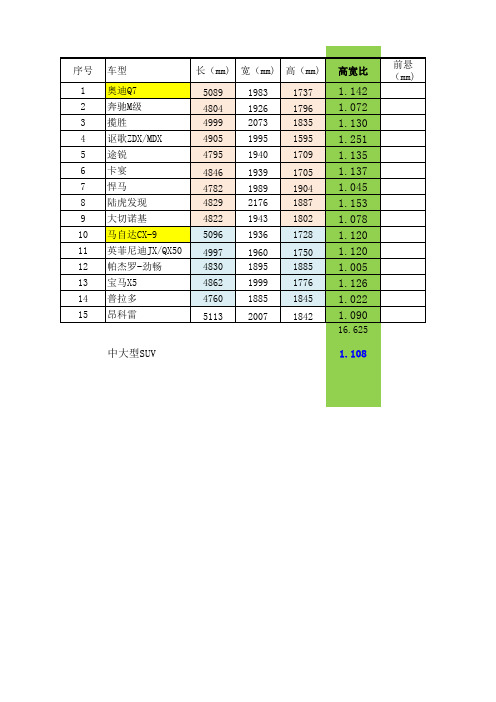
宽(mm) 1983 1926 2073 1995 1940 1939 1989 2176 1943 1936 1960 1895 1999 1885 2007
高(mm) 1737 1796 1835 1595 1709 1705 1904 1887 1802 1728 1750 1885 1776 1845 1842
5+2座参数 排量
0.592 0.607 0.585 0.561 0.603 0.597 0.594 0.597 0.605 0.564 0.580 0.576 0.603 0.586 0.591
8.841
3.7L 3.5L 3.0L 3.0T/4.4T 2060 2180-2380 3.0L 3.0T/4.4T 4.0L
12年2月 销量
12年3月 销量
12年4月 销量
12年5月 销量
12年6月 销量
12年7月 销量
12年8月 销量
12年9月 12年10月 12年11月 12年12月 11年1月 销量 销量 销量 销量 销量
11年2月 销量
11年3月 销量
11年4月 销量
11年5月 销量
11年6月 销量
11年7月 销量
0.589
5+2座参数 整备质量 (kg)
7座参数 整备质量 前轮距 后轮距 油箱容 后备箱容 排量 轮胎 接近角 离去角 (kg) (mm) (mm) 积(L) 积(L)
2063 1960/2072 2120 2180-2455 2210-2310 3.6L 2316
最小离 工信部 最高车 地间隙 油耗 速
高宽比
前悬 (mm)
1.142 1.072 1.130 1.251 1.135 1.137 1.045 1.153 1.078 1.120 1.120 1.005 1.126 1.022 1.090
汽车布置断面设计

二、典型断面实例
3.风窗玻璃上横梁中部断面
05
优化前
优化后
优优 化化 前后 :: 红绿 色色
通过优化腔体和顶盖内衬的位置,得到: 1、缩短前挡风玻璃上端的黑边,使得造 型更美观; 2、较好的前上视野,减小驾驶员前上方 压抑感; 3、较好的结构强度和刚度,较强的防水 性和防噪性等。
汽车总布置培训课程
一、断面基本知识
2. 断面的分类
概念断面 Concept Section
主断面 Critical Section Typical Section
设计断面 Engineering Section
简概 单念
复精 杂确
汽车总布置培训课程
一、断面基本知识
3. 断面的作用
定义整车的结构框架及结构硬点(尺寸、特征比例); 定义整车空间(乘员、行李区域、维修/装配、功能/性能实现、异响…); 定义整车人机关系(视野、空间、操作、进出、通过、遮蔽…); 定义整车体态; 定义整车符合与结构相关法规要求(牌照板、低速碰撞、灯具…); 对造型图/CAS/A面的结构可行性进行定量研究; 对项目构想方案进行图示表示,对方案结构的可行性进行初步研究; 定量研究局部结构的可行性(间隙、搭接、固定、密封…); 定量分析功能实现的可行性(运动包络、运动协调性…); 定量分析结构的刚度和强度(截面刚度计算、截面失稳…); 定量分析零部件的工艺制造性(冲压、注塑…); 为工程化设计提供结构依据; …
应充分考虑,同时在断面结构设计时简单的变化即可优化 出20mm的空间。(如上图所示) 2. 最下端的密封可以有效避免泥水溅在侧围下护板上,可保 证在乘员上下车时小腿附近的整洁。(如左图所示) 3. 侧围下焊接边的位置藏在外部视野线之外,可有效提高整 车的品质感。 (如左图所示)
车辆基地总体布局方案

车辆基地总体布局方案一、简介车辆基地总体布局方案是指对车辆基地进行整体规划设计,以达到最优的空间利用效果和最高的生产效率。
在车辆基地总体布局方案中可以包括对停车场、修配车间、仓库、办公区等不同功能区域的规划布局。
二、停车场布局方案停车场是车辆基地中最为重要的区域之一,合理的停车场布局直接影响到整个车辆基地的运行效率。
因此,在车辆基地总体布局方案中,停车场的布局需要特别重视。
一般来说,停车场的布局需要考虑以下几个方面:1.面积:停车场的面积需要根据基地内车辆数量来确定。
如果停车场面积过小,会导致停车难、拥堵等问题。
而停车场面积过大则会造成资源浪费。
2.出入口:停车场的出入口需要避免相互干扰,同时也要方便车辆的进出。
出入口的设计需要考虑到地形、道路宽度、旁边建筑物等因素。
3.停车位:停车位的设计需要充分考虑车辆尺寸、排列方式、停车道路宽度等因素,确保车辆停放稳定,便于进出。
4.安全设施:停车场的安全设施包括防护设备、防盗设备等,能够为车辆安全提供保障。
三、车辆修配车间布局方案车辆修配车间是车辆基地的核心区域之一,是处理车辆保养、维修、检测等工作的场所。
因此,车辆修配车间的布局方案需要十分科学合理。
一般来说,车辆修配车间的布局方案需要从以下几个方面考虑:1.区域划分:车辆修配车间需要将各种不同类型的工作区域进行区分,例如:机械维修区、电气检测区、喷漆区等。
具体划分需要考虑到车辆维修保养的流程,确保不同区域能够协调顺畅地进行工作。
2.空间利用:车辆修配车间的空间利用需要最大化,同时需要确保车辆内部保持宽敞。
在车辆修配车间的空间布置中,需要充分考虑不同车辆的尺寸和形状。
3.省工、节能:车辆修配车间需要充分考虑省工、节能的原则,例如采用自动化生产设备和节能灯具进行改造升级。
4.安全设施:车辆修配车间需要配备各种安全设施,例如:防火设施、消防器材、疏散设备等。
四、仓库布局方案仓库是存放车辆配件、工具和维修用品等物品的场所,对车辆保养的效果具有重要影响。
车辆基地总体布局方案

车辆基地总体布局方案1. 简介随着社会的发展和经济的快速增长,汽车逐渐走进我们的生活。
在汽车流通过程中,车辆基地作为车辆集散、保养、维修、管理和调度的重要基础设施,在整个汽车行业中发挥着至关重要的作用。
因此,在合理评估所需服务和客户群体的基础上,车辆基地的总体布局方案应该精心设计,尊重城市固有地形和环境,同时兼顾商业、居住和生产功能。
2. 设计原则2.1 功能性原则车辆基地首要考虑的是服务对象的相关需求。
为了实现基地的功能性,需要对停车场、维修、养护、物流以及车辆调度等功能区别明确布局,进行合理规划。
2.2 效率原则汽车作为现代人们在出行过程中不可或缺的工具,其需求不仅在数量上持续增长,使用频率也在不断提高。
为了提高基地的效率,基地应该摒弃旧有的管理方式,采用高科技手段,如智能机器人、自动售票机等等,来提高基地的工作效率。
2.3 环保原则设置车辆基地时应该考虑到环境保护,减少环境污染。
应该构建集成化的垃圾处理设施和水安全补给设施,以便更好地提高基地的环保性。
3. 总体布局方案3.1 区域划分车辆基地的总体布局方案应该考虑到基地的可持续性,基地内应设有装载和停放面积的区域、注册处、维修和养护区、办公室、储存和机房。
3.2 停放面积为了保证汽车基地的高效空间利用,停车场应该构建在基地的边缘,而不是中心部分。
同时,在停车场的划分上,应该根据大小、类型和使用情况来分别设置不同的区域。
3.3 办公区基地内应该划分出办公区,以便提供优质的办公环境。
办公区应该向基地内部开放。
在办公室的设计上应该重视自然采光和环境监测系统,以减少污染,并保证员工的舒适系统。
3.4 维修和养护区维修和养护区应该放在基地的前端以便于车辆维护和养护。
同时,这个区域应该设置在公路的一侧以便于对外业务。
3.5 物流区物流区是对整个基地进行货物流动管理的重要区域。
在物流区域的规划中,应注重道路的通畅性以便外部的便捷进出车辆。
该区域还应该加强安全性管理以确保车辆、物品和人员的安全。
《汽车设计总布置》课件

人体工程学设计还需要考虑不同人群 的需求,如不同身高、体型和年龄的 人群,以确保设计的适用性和通用性 。
人体工程学设计包括座椅设计、仪表 板布置、门把手设计等,旨在提高驾 驶员和乘客的舒适性和便利性。
空间优化设计
空间优化设计:空间优化设计是 汽车设计总布置中的重要技术之 一,主要关注车内空间的合理利
性能匹配与优化包括发动机匹配、悬挂系统设计、轮胎选择等,旨在提高汽车的整 体性能和驾驶体验。
性能匹配与优化还需要考虑不同车型的需求,如跑车、家用车和商用车等,以满足 不同车型的性能需求和特点。
安全性与可靠性设计
1
安全性与可靠性设计:安全性与可靠性设计是汽 车设计总布置中的重要技术之一,主要关注汽车 的安全性能和可靠性。
。
性能试验
对样车进行各种性能试 验,如道路试验、台架 试验等,以验证设计的
有效性。
结构验证
对样车进行严格的耐久 性和安全性试验,如碰 撞试验、腐蚀试验等, 以确保满足法规和用户
要求。
03
汽车设计总布置关键技术
人体工程学设计
人体工程学设计:人体工程学是汽车 设计总布置中的重要技术之一,主要 关注驾驶员和乘客的舒适性和便利性 。
《汽车设计总布置》ppt课件
$number {01}
目录
• 汽车设计总布置概述 • 汽车设计总布置流程 • 汽车设计总布置关键技术 • 汽车设计总布置案例分析 • 汽车设计总布置未来发展趋势
01
汽车设计总布置概述
定义与特点
定义
汽车设计总布置是指在汽车产品设计过程中,对车辆整体及 各子系统、部件的尺寸、结构、功能、工艺、成本等进行全 面的权衡与协调,以确保最终产品符合设计要求的过程。
汽车总布置设计规范
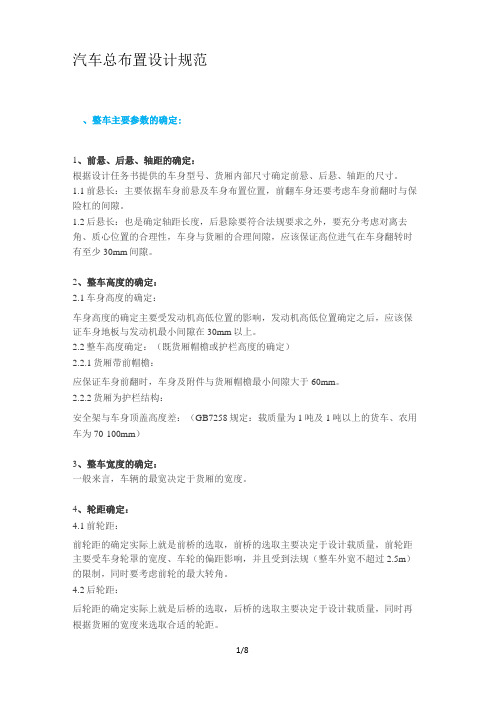
汽车总布置设计规范、整车主要参数的确定:1、前悬、后悬、轴距的确定:根据设计任务书提供的车身型号、货厢内部尺寸确定前悬、后悬、轴距的尺寸。
1.1前悬长:主要依据车身前悬及车身布置位置,前翻车身还要考虑车身前翻时与保险杠的间隙。
1.2后悬长:也是确定轴距长度,后悬除要符合法规要求之外,要充分考虑对离去角、质心位置的合理性,车身与货厢的合理间隙,应该保证高位进气在车身翻转时有至少30mm间隙。
2、整车高度的确定:2.1车身高度的确定:车身高度的确定主要受发动机高低位置的影响,发动机高低位置确定之后,应该保证车身地板与发动机最小间隙在30mm以上。
2.2整车高度确定:(既货厢帽檐或护栏高度的确定)2.2.1货厢带前帽檐:应保证车身前翻时,车身及附件与货厢帽檐最小间隙大于60mm。
2.2.2货厢为护栏结构:安全架与车身顶盖高度差:(GB7258规定:载质量为1吨及1吨以上的货车、农用车为70-100mm)3、整车宽度的确定:一般来言,车辆的最宽决定于货厢的宽度。
4、轮距确定:4.1前轮距:前轮距的确定实际上就是前桥的选取,前桥的选取主要决定于设计载质量,前轮距主要受车身轮罩的宽度、车轮的偏距影响,并且受到法规(整车外宽不超过2.5m)的限制,同时要考虑前轮的最大转角。
4.2后轮距:后轮距的确定实际上就是后桥的选取,后桥的选取主要决定于设计载质量,同时再根据货厢的宽度来选取合适的轮距。
二、驾驶室内人机工程总布置:1、R点至顶棚的距离:>9102、R点至地板的距离:370±1303、R点至仪表板的水平距离:>5004、R点至离合器和制动踏板中心在座椅纵向中心面上的距离:750~850(气制动或带有助力器的离合器和制动器,此尺寸的增加不大于100)5、背角:5~28°6、足角:87~95°7、转向盘外缘至侧面障碍物的距离:>100(轻型货车>80)8、转向盘中心对座椅中心面的偏移量:<409、转向盘平面与汽车对称平面间夹角:90±510、转向盘外缘至前面及下面障碍物的距离:>8011、转向盘下缘至离合和制动踏板中心在转向柱纵向中心面上的距离:>60012、转向盘后缘至靠背距离:>35013、转向盘下缘至座垫上表面距离:>16014、离合、制动踏板行程:<20015、离合踏板中心至侧壁的距离:>8016、离合踏板中心至制动踏板中心的纵向中心面的距离:>11017、制动踏板纵向中心面至通过加速踏板中心的纵向中心面的距离:>10018、制动踏板纵向中心面距转向管住纵向中心面的距离:50~15019、加速踏板纵向中心面至最近障碍物的距离:>6020、变速杆和手制动手柄在任意位置时,距驾驶室内其他零件或操纵杆的距离:>50三、底盘总布置:1、车架宽度的确定:1.1发动机安装部位的车架外宽的确定a•发动机宽度尺寸:特别是在车架纵梁附近的发动机宽度。
车身总布置的工作内容

车身总布置的工作内容①根据整车设计要求确定车身各部分尺寸包括:乘客门、司机门、安全门、行李舱、地板高、侧窗数量及高度、内高、内宽等;②确定整车外形——前后围、车顶、侧围的大致曲线和尺寸,前后风窗位置与角度等;③驾驶区布置——方向盘位置(角度)、仪表板、驾驶员位置及操纵机构和踏板的相互位置;④乘客区布置——座椅布置、通道宽度、内高等;⑤空调系统的位置——制冷、采暖、除霜、通风换气、空气净化装置的位置及管道位置;⑥行李舱大小及位置;⑦视野设计校核;⑧乘客上下车方便性确定;⑨安全性设计——被动安全性(安全带、扶手、软化等)。
轿车车身总布置的内容:①确定车身内部、外部尺寸。
②确定乘坐与操纵空间。
③校核各项性能及法规要求的尺寸数据。
④确定车身的悬置形式及位置。
⑤确定发动机、传动系占用的空间,并对有关总成提出反要求。
⑥确定备胎、燃油箱,以及各种液罐、蓄电池及行李舱的位置。
⑦确定由于车身附件及其它装置的特殊要求引起的车身结构及布置的变动。
客车车身总布置设计的工作内容1.根据整车设计要求确定车身各部分尺寸——乘客门、司机门、安全门、行李舱、地板高、侧窗数量及高度、内高、内宽等;2.确定整车外形——前后围、车顶、侧围的大致曲线和尺寸,前后风窗位置与角度等;3.驾驶区布置——方向盘位置(角度)、仪表板、驾驶员位置及操纵机构和踏板的相互位置;4.乘客区布置——座椅布置、通道宽度、内高等;5.空调系统的位置——制冷、采暖、除霜、通风换气装置等的位置;6.行李舱大小及位置;7.视野设计校核;8.安全性设计——被动安全性(安全带、扶手、软化等)。
客车的布置型式——以大客车为例现代大客车几乎全部采用平头式。
根据发动机位置的不同,大客车布置型式有三种、前置、中置、后置。
共性:平头、厢式、后轮驱动;个性:按发动机位置的不同,分为前、中、后置三大类。
1、前置发动机式优点:10.通用性好——与货车通用部件多;20、发动机冷却条件好,维修、拆装方便;30、传动系及操纵机构简单,易于布置。
- 1、下载文档前请自行甄别文档内容的完整性,平台不提供额外的编辑、内容补充、找答案等附加服务。
- 2、"仅部分预览"的文档,不可在线预览部分如存在完整性等问题,可反馈申请退款(可完整预览的文档不适用该条件!)。
- 3、如文档侵犯您的权益,请联系客服反馈,我们会尽快为您处理(人工客服工作时间:9:00-18:30)。
摘要现代轿车设计处处强调以人为本,安全、舒适、环保、节能一直是轿车设计的主题和追求的目标。
人机工程布置设计不仅关系到有效利用车内空间及提高乘坐舒适性、安全性,而且还会影响到整车内外造型效果,进一步影响到整车的总体性能和商品性,所以人机工程学在轿车设计开发过程中的应用研究占据着重要的地位。
本文首先对传统的车身设计方法和现代车身方法进行了比较,并说明了本文采用的设计方法。
本次设计根据汽车造型设计的发展和车身设计方法的原则进行了汽车造型设计。
然后进行车身总布置参数的确定及整车坐标零线的确定,还应用人机工程学确定人体模型和驾驶员最舒适姿势。
接着确定了H点,座椅设计,眼椭圆设计还有头部包络面和包络线。
最后各个附件的设计及确定。
关键词:人机工程学;车身总布置;眼椭圆AbstractThe design of modern cars everywhere emphasized people-oriented, of safety, comfort, environmental protection, energy saving has been the subject of car design and the pursuit of goals. Ergonomic layout design is not only related to the effective use of the car space and improve the comfort, safety, but also affect the modeling results both inside and outside the vehicle, and further affect the overall vehicle performance and commercial, so Ergonomics In the process of car design and development of applied research occupies an important position.In this paper, the body design of the traditional methods and modern methods of the body, and that the design methods used in this paper.The automotive design is based on the development of automotive design and body design principles,then make sure of the total layout parameters and the zero line of the vehicle coordinates,also apply ergonomics to determine the models and most comfortable body position.And determine the H point,seat design,the eyellipse design,the head envelope surface and the envelope curve.Finally, design and identify the various accessories.Key words:Ergonomics;Auto Body layout;eyellipse目录第1章绪论 (1)1.1 本次设计题目的研究的内容和意义 (1)1.2 车身总布置原则 (1)1.3 本次设计的任务 (2)1.4 轿车的分类及特点 (3)1.4.1 按整车结构分类 (3)1.4.2 按有无车架分类 (4)1.4.3 按车身外形分类 (5)1.5 轿车车身设计的要求与特点 (5)1.6 本次设计预期达到的目的 (6)第2章车身设计方法 (8)2.1 传统的设计方法 (8)2.2 现代的设计方法 (8)2.3 本次设计的设计方法 (9)2.4 座椅的布置方法 (10)第3章造型设计 (12)3.1 造型的发展史 (12)3.2 外型设计 (13)3.3 发动机罩外板 (14)第4章整车布置坐标零线确定 (15)第5章车身总布置尺寸参数的确定 (17)5.1 车身外廓尺寸确定 (17)5.2 车身内部布置的设计 (18)5.2.1 汽车车身内部布置设计方法 (18)5.2.2 汽车车身内部布置工具 (19)5.2.3 人体百分位及H点人体模型 (19)5.2.4 人体的舒适驾乘姿势 (21)5.2.5 驾驶员座椅布置 (22)5.2.6 离合器、制动器、油门踏板布置 (24)5.2.7 手操纵件的布置 (24)5.2.8 仪表盘总成的布置 (26)第6章眼椭圆及驾驶员视野校核 (27)6.1 驾驶员眼椭圆的概念 (27)6.2 驾驶员眼椭圆样板制作 (28)6.3 眼椭圆在车身视图上位置的确定 (30)6.4 驾驶员视野性校核 (31)6.5 驾驶员的头廓包络线及头廓包络面 (31)第7章后围板、行李箱及备胎等附件的布置 (34)7.1 后围板和行李箱的布置 (34)7.2 油箱、备胎的布置 (34)7.3 排气管的布置 (34)第8章结论 (35)参考文献 (36)致谢 (37)附录 (38)第1章绪论1.1本次设计题目的研究的内容和意义本次设计是现代SUV轿车车身总布置设计。
车身总布置决定汽车车内空间的利用情况,同时也影响整车内外造型和乘坐舒适性、操纵便利性、安全性等关键特性。
一款新车在整个设计工程中车身总布置设计占有重要的地位。
其中室内布置,必须满足人机工程学的要求,以求在规定尺寸内能令驾驶员操作准确、方便以及满足乘员对乘坐舒适度的要求。
车身外布置在满足相关法规和美学的基础上实现对空气动力学的最好应用。
车身总布置设计是在整车总布置设计的基础上进行的,主要是围绕人机工程学原理并充分考虑到制造工艺、材料特性、完全特性,在满足车身造型的要求下,对各种机构、电气设备、车身内饰总成和部件(仪表板、操纵机构、座椅等)的所在位置,以及车身室内空间大小和车身主要技术参数进行设计、确定的过程。
车身总布置设计是概念设计的重要内容,它是其它设计阶段的前提和基础,是汽车设计的最初始的步骤,是整车开发周期中至关重要的阶段。
车身总布置设计是否合理,将直接影响整车的使用性能甚至决定着车身设计的成败。
因此本设计具有一定的实际应用意义。
1.2车身总布置原则车身布置的第一阶段与车身概念设计同时进行的,该阶段的主要任务,是考虑整车的形式,车身与整车总布置关系,而后跟各总成形式与整车总布置的要求确定车身的型式。
对于骄车,主要是确定成员人数、车门数、座椅数、车身造型风格,车身级别等。
在车身总布置的整个过程当中,需遵循以下原则。
(1)由于轿车是供人乘坐的,主要满足人的乘坐要求,即满足乘坐舒适性、居住性、操纵轻便性、温度调节性、视野性、上下车方便性及安全性等方面的要求。
(2)从整车的经济性和行驶稳定性考虑,要有良好的空气动力学。
(3)具有对地盘各总成、发动机及电气设备的良好的接近方便性、维修保养方便性。
(4)从降低制造成分,提高整车的动力性、经济性考虑,要尽量减轻车身质量,并具有良好的冲压、焊接、装配及涂装工艺性。
(5)按照汽车的级别、用途及法规选择各种车身附件,同时确定必装件和选装件。
(6)在满足性能要求的前提下,尽量减少车身的外形尺寸。
在外形尺寸一定的情况,尽量扩大车内空间,尤其是尽量扩大宽度方向的尺寸。
(7)充分考虑车身与整车及各总成的协调性,确保良好的密封、通风换气、隔音隔热及防震等性能。
(8)必须满足国际、国家有关的各种法规和标准规定要求。
(9)充分考虑车型的系列化、通用化。
1.3本次设计的任务在这项设计工作中,既有汽车各总成间的联系问题,又有人(司机和乘客)与汽车之间的联系问题。
解决人车之间的联系问题属于人—机工程设计,在汽车设计工作中占有极重要的位置。
例如:驾驶操作空间尺寸的布置,车内乘客空间尺寸的布置,座椅尺寸参数与特性参数的选择,车身的外观造型与彩色,仪表板的造型及仪表的选型与布置,车身内饰材料与色彩的选择,汽车的驾驶视野,汽车的驾驶性能与乘坐性能等,这些与人的感觉与视觉有直接联系的方方面面,都会对汽车产品的设计质量、品位和市场竞争力产生巨大的影响。
还应取得整车的有关性能之间,相关总成的参数之间的理想匹配。
应用意义:通过现代SUV车身总布置设计,初步掌握利用计算机辅助设计车身总布置设计的方法。
利于改善现代SUV车身总布置设计改善其市场竞争地位。
给消费者设计出更优质的汽车。
本次毕业设计的题目是现代SUV车身总布置设计。
设计内容及要求1)结合汽车设计,汽车车身设计所学的内容,对中华尊驰轿车进行车身总布置设计。
2)各部分布置要协调一致,内部布置要符合人机工程学的要求,外形要符合有关法规的要求,同时要兼顾空气动力学及美学的要求。
3)完成设计图纸一套,包括内部布置图及外形图;发动机罩外板零件图。
有关尺寸要标注正确。
4)说明书一份;外文翻译一篇。
1.4轿车的分类及特点1.4.1 按整车结构分类(1)发动机前置前驱(FF)FF布置形式具有良好的转向操纵稳定性;由于省去传动轴,对改善室内居住性、座椅和地板的布置有利;降低离地间隙,提高动力性。
目前在轿车上得到了广泛运用。
本次设计采用了发动机前置前驱。
图1.1 发动机前置前驱(2)发动机前置后驱(FR)FR布置形式有利于车室内和行李箱的布置;由于轴荷分配较好,所以转向稳定性和动力性较好;但由于有传动轴,不利于座椅和地板的布置。
图1.2 发动机前置后驱(3)发动机后置后驱(RR)RR布置形式前悬短、后悬长、后轴负荷大,转向不稳定;不利于行李箱的布置,所以多功能轿车不宜采用这种布置形式。
图1.3 发动机后置后驱1.4.2 按有无车架分类(1)有车架结构这种形式将发动机以及底盘个总成安装在有整车长的完整车架上,并且车身通过橡胶悬置装置与车架相连,车架是整车承载的主体,有称为非承载式车身结构。
(2)无车架结构这种形式将发动机和底盘个总成直接安装在车身体上,车身承受整车载荷,又称为承载式车身结构。
本次设计采用了无车架机构。
图1.4 非承载式车身结构图1.5 承载式车身结构1.4.3 按车身外形分类轿车按其车身外形特证,一般分为厢型、流线型和敞篷型。
另一方面,从轿车的外形和空间利用率来分为两厢式和三厢式。
两厢式轿车具有最大限度地利用车身底部面积之上的空间特征,是现代多功能轿车的主流。
